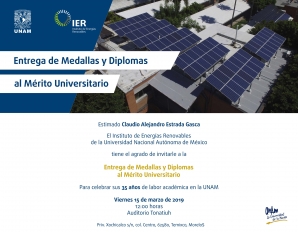Mostrando artículos por etiqueta: Chemical Engineering Research and Design
Solar production of WO3: a green approach
H.I. Villafán-Vidales, A. Jiménez-González, A. Bautista-Orozco, C.A. Arancibia-Bulnes, C.A. Estrada.
Abstract
The tungsten trioxide (WO3) is a promising material with important technologic and scientific applications, due to its electrochromic, gasochromic and photochromic properties. Usually, this material is synthesized following several routes, for example, sputtering, chemical deposition, sol-gel, hydrothermal, among others. However, these methods are complicated, have long processing times and use several chemicals with the possibility of keeping undesirable impurities. In this context, concentrated solar energy is an interesting and feasible option to process materials at a low cost and without greenhouse gas emissions. In this work, a simple and green synthesis method of WO3 by using the Solar Furnace of the Renewable Energy Institute of the National University of Mexico is presented. Tungsten oxide powder is obtained by means of tungsten electrodes in a high-temperature solar reaction chamber designed to work with concentrated solar energy under controlled conditions of the gas atmosphere. The oxidation reaction was carried out for three different temperatures: 600°C, 800°C and 1000°C, and for each temperature three different oxygen molar fractions were studied: 0.33, 0.41 and 1. Some results indicate the oxygen molar fraction does not affect the phase transformation and the WO3 triclinic was the most stable phase, appearing in all the temperature ranges and concentrations. The synthesis reported in this paper is presented as a green alternative in the development of processes for the synthesis of WO3, which promote renewable energy sources with very low greenhouse gas emissions and without toxic residuals.
Transient heat transfer simulation of a 1 kWth moving front solar thermochemical reactor for thermal dissociation of compressed ZnO
H.I. Villafán-Vidales, S. Abanades, M. Montiel-González, H. Romero-Paredes, C.A. Arancibia-Bulnes, C.A. Estrada.
Abstract
A 1 kWth cavity-type solar reactor devoted to the thermal reduction of volatile oxides as part of a two-step thermochemical cycle is analyzed numerically. The thermochemical reactor consists of a vertical-axis cavity-type receiver in which the reactant is injected from the bottom in the form of an ascending rod made of a stack of zinc oxide compressed pellets undergoing thermal dissociation. A transient heat transfer model allows the simulation of the thermal behavior under real conditions for the rod of reacting particles exposed to concentrated solar radiation. The developed numerical model couples radiation, conduction and convection heat transfers to the kinetic of the reaction. The incident solar irradiation on the reactant surface is obtained using the Monte-Carlo ray tracing technique applied first to the solar concentrator and second to the reactor cavity. The model is used to predict the temperature profile from the irradiated front surface of the compressed reactant, the evolution of outlet oxygen molar flow-rate during the reduction reaction and the instantaneous thermochemical efficiency, as a function of time. The calculated results are compared with the experimentally obtained data. The agreement between experimental data and simulation related to both the temperature and the oxygen progress is fairly good with Ea = 380 kJ mol−1 and k0 = 246 × 106 mol m−2 s−1 for the kinetics of the ZnO dissociation reaction.

